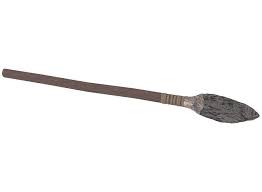Key Point: The spear is a polearm weapon characterized by a pointed, usually metal, tip affixed to a long shaft, historically used for thrusting or throwing in combat.
In this series on polearms, we will discuss the spear. The oldest and most widely used polearm. You will see what a spear is, how it was used, and how it changed throughout the centuries.
Now, before we begin it’s appropriate to establish the definition of a spear. So … What is a spear?
The spear is a type of polearm that has been used throughout history by various civilizations. It consists of a long wooden shaft with a pointed metal tip and was used for thrusting and jabbing in combat. The spear was effective due to its long reach, which allowed soldiers to engage enemies from a safe distance, and its relatively low cost of manufacturing. Variations of the spear include the pike, which was designed for use in tight formations, and the javelin, which was designed for throwing at enemies from a distance.
That was the short takeaway of the article. Now, let’s go deeper into the topic by discussing its history and origin.
Origin Of The Spear

The spear is one of the oldest weapons in human history. Archaeological evidence suggests that it was in use as early as 400,000 BCE, during the Paleolithic period. The earliest spears were simple wooden shafts with sharpened points made of bone or stone. These were used for hunting, as well as for self-defense against predators.
The main job of the spear was to enable its user to inflict damage at a safe distance. It did this by distancing the user from the target.
Bronze Age Spear
So as human societies became more complex, the spear evolved into a more sophisticated weapon. The shafts were lengthened, and metal points were added. By the Bronze Age (around 3000 BCE), the spear had become a staple of military warfare, used by soldiers in nearly every civilization around the world.
Ancient Greece Spears
In ancient Greece, the spear was a primary weapon of the hoplite, the citizen-soldier who made up the backbone of the Greek army. And the most famous type of Greek spear used in this period was the doru. Which was about 6-8 feet long and had a leaf-shaped metal point. So, as you can imagine having one of those long things pointed at you must have been terrifying.
Medieval Spear
In medieval Europe, the spear evolved into a variety of different forms. Mainly the pike and the halberd. These weapons were used by professional soldiers, who formed tight formations and used their long spears to hold off enemy charges.
And the tactics? Let’s see how the tactics changed throughout the years.
Spear Tactics Throughout The Ages
Let’s go through each period one by one.
Ancient Times:
In ancient times, the spear was often used in large formations, such as the phalanx. This is where soldiers stood side-by-side with their spears pointed outward. This formation was used by the Greeks, and it proved to be highly effective against cavalry charges, as well as against other infantry.
Spear Dimensions: The spears used by the Greek and Macedonian phalanxes were typically around 18 feet long (about 5.5 meters) and made of ash wood. The spearhead, known as a doru, was usually made of iron and measured about 12-14 inches in length (about 30-35 centimeters).
Another tactic was to use the spear in conjunction with a shield, allowing soldiers to protect themselves while thrusting the spear forward to attack their enemies.
Medieval Times:
During the medieval period, knights and other mounted soldiers used the spear as a primary weapon for jousting competitions. The goal was to use the spear to knock one’s opponent off their horse. On foot, soldiers used a variety of tactics with the spear, including thrusting from behind a wall of shields or holding it with two hands to increase the force of the strike.
Gunpowder Era:
With the advent of gunpowder weapons, the use of the spear in warfare declined significantly. But it was still used by certain groups, such as the Swiss pikemen in the 16th century. These soldiers formed a wall of spears, which proved to be effective against charging cavalry.
For example in the pike and shot formation, which was widely used in Europe during the 16th and 17th centuries, pikemen formed a wall of spears to protect musketeers from charging cavalry. And the musketeers fired their muskets from behind the safety of the pikemen’s wall. This formation was highly effective against cavalry charges, as the pikemen could keep the horses at bay while the musketeers picked off the riders from a safe distance.
Since it was so effective for so long. let’s take a look at why it fell from use.
Downfall Of The Spear
The introduction of firearms in the 16th century marked the beginning of the end of spears in the military.
So while spears continued to be used in some armies as late as the 18th century, they were gradually replaced by firearms. They were superior since they allowed soldiers to engage the enemy from a distance.
The use of spears also required extensive training and discipline to be effective. While you could give a simple musket to a farmer and have him be semi-competent much much faster.
In Conclusion
Thank you for taking the time to read this article. I hope you learned a thing or two. If you want to see what followed the spear, then check this out. It’s an article on the javelin.
Sources: